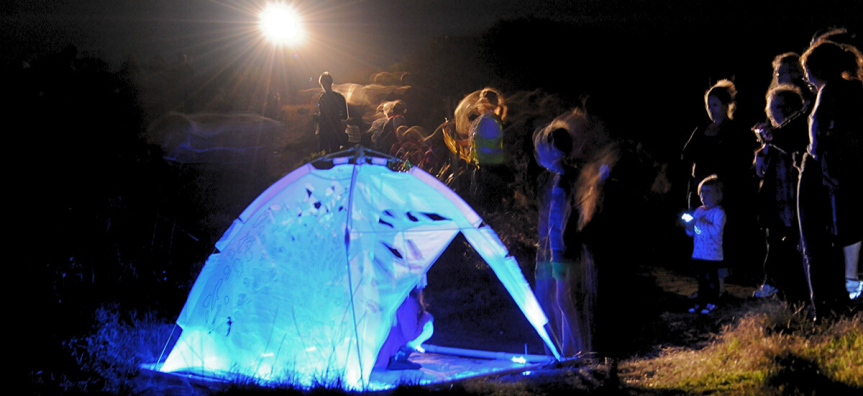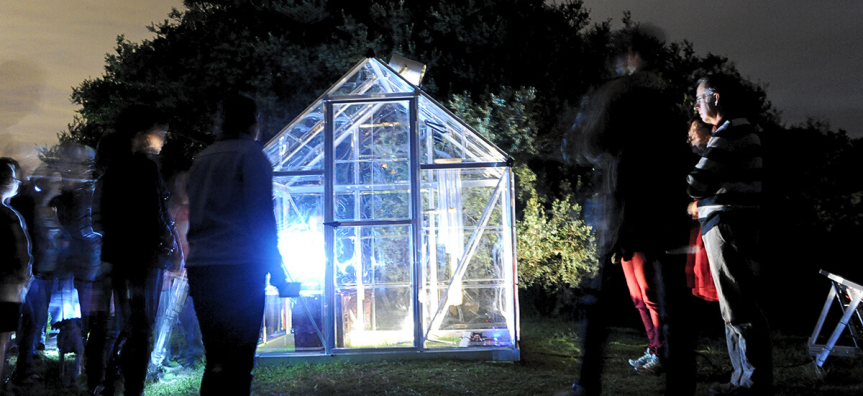
Held in May 2014, La Lune was an outdoor sculpture exhibition that lit up the Long Reef Headland, exploring the idea of energy in art. Many of the works physically produced energy, were designed to be self-sustaining, or mirrored the potential of larger scale energy production systems as they balanced production and load.
The project was produced by the former Warringah Council in conjunction with the Environment Research Initiative for Art (ERIA) at UNSW School of Art & Design (formerly College of Fine Arts, UNSW).
As we approach the tenth anniversary of this memorable exhibition, we interviewed the original curator of La Lune, Allan Giddy, Director of ERIA at UNSW.
Interview with Curator Alan Giddy
What is the La Lune origin story?
I was approached by Warringah Council, who were looking for something like the Strandbeest by Theo Jansen. They wanted something similar, but it would have cost a lot of money to do something like that, something wind or solar-powered. I thought about it, and we'd recently had a show called Desert Equinox in Broken Hill, which was Australia's first solar-powered art show. It was very successful, so I when I was asked by Warringah Council to propose something, I thought why don't we do something like that? We could ramp this up a little and try a solar or energy-producing art show. And that got accepted.
It's a specialised skill set, so we gathered artists and students who had already worked with the technologies. Most of the artists had done it before, barring maybe about five of them, and that made life a little bit easier. We then conceived the works and installed them along that beautiful coastline at Long Reef Headland.
We were planning for around 500 to 900 at the opening, but I had done a radio interview about the show, and the word was out. People came from miles around to see the show. We think there were about 9,000 people at the opening.
What was the original plan, and how did it unfold?
It was planned to run for ten nights, all in a row, with people moving from one end to the other. There was car parking down by the Surf Life Saving Club, but not enough for 9,000 people!
The golf course was on board, and they were lovely. People could go there for meals or drinks, so they benefited from all of that. Council provided security.
The headland was just full of people, and there were no barriers because we didn't think that was ever going to be a problem. Then somebody had a medical incident, we think an epileptic seizure, and the ambulance had to come and the whole thing was a bit hair-raising.
Following a quick meeting Council staff set up barriers and we let people through at timed intervals. We set up a screen so people could read about the artworks while waiting for their turn to enter, and they could talk to the kids about what they were going to see. Everyone settled down a bit then because parents knew what to expect. By the second night we had it all under control.
Down at the Life Saving Club we had stalls and refreshments, and we've used this as a template for following events in Randwick and at Broken Hill last year. On the entry side of the barriers we can have anything like commercial stalls, or education about the works. But once the audience enter the show, it should be nothing but art. And it should be free. We played it that way at La Lune, and it settled down and became really popular. I think we got about 35,000 people in total, over the 10 nights.
It was hard work keeping it safe and making sure there was no damage, pollution or waste - and making sure we left that beautiful coast exactly as we found it. In the end we had no negative ecological impact on the site.
The Events team at Warringah Council were really, really good. I've never encountered a team like them. I was really happy with the crew and how they let me do what I did.
All the works were solar powered, how did that work?
We had a big solar module producing all the energy. It was up the track from the artworks.
In those days if there was just one projection work that needed a solar array, it needed about $7,000 worth of equipment just to get it working. Today I can make that same project for about $900, and I don't need solar at all, just a portable lithium battery. Things have changed a lot in a decade, mainly in load-shedding and cost.
For security, we would pull any expensive equipment into a central storage container at night, but to be honest, the crowd was well behaved - and so receptive. While we were installing the works, people would keep coming up to ask, "what are you doing?". They would be intrigued when we told them and say they'd come along the following night and bring friends. That was great. I just thought the reception was wonderful.
How was the show funded?
Warringah Council provided the funding, and I managed to get some sponsorship from Jaycar. They gave us a hefty discount on equipment.
The artists were all paid a fee and used the discount from Jaycar for bits and pieces of equipment.
The Council really sheltered us from the administration of the event. All I had to do was be on the ground, and make sure the artworks were safe. I just had to keep it all working and keep the artists happy. Everything else was handled by the Council team.

Do you feel that environmental art has changed over the decade, since La Lune? In Sydney or in Australia?
There are two key aspects to that - the cultural and the technological - if it’s possible to separate the two.
Technologically, we're light years away from 10 years ago. The load-shedding is amazing now. The lighting systems are minuscule compared to those required to do the same job ten years ago. Everything we did at La Lune, you could do now do cheaper and easier.
What do you think will happen in the next decade?
Huge changes are afoot. Energy batteries are going forward in leaps and bounds, they're going to get even smaller and cheaper. That would be the big one. Lighting has probably got to where it's going, there's not much further room for improvement there.
There may be a breakthrough at some point where even lithium becomes redundant. There are lots of people working with saltwater batteries, and vanadium redox batteries. If you can invent the next battery, you're going to be rich.
What about culturally and politically? Do you think a show like this would be commissioned now? Do you think that people have the same interest in solar powered artwork, or, do you think artists have the same interest in making this kind of work?
Yes, it’s really unfolding. It can be more spectacular now. You can do more with it.
We can have projections. I can do all sorts of stuff that wasn't possible, and it's quite simple now. In those days, it would have required major technology to do the graphics and animations that people can do easily now.
What about funding bodies and government? Do you feel that their interest is increasing in this kind of work?
Yes, there is still funding for these kind of projects, but the issue is still that artists don't get paid enough. You continually get told this in the arts – “it'll be great for your career, people are going to see it ... it's great exposure”. But why do artists need great exposure again and again and again, when the work's not paying for itself? Artists need to be paid for their work.
For many, it’s mostly a labour of love - but we need to be more professional. You can produce a labour of love, and also be paid for your work.
Events like La Lune often have a commercial side. They have stalls selling beer or food. We need to create a system where the artists get some sort of percentage from all the other things that go on around the artworks or event, that the artworks have brought about. That wouldn’t be too difficult.
What is the long-term impact of an event like La Lune, at a grassroots level?
The nice thing about this sort of artwork is that there are two ways for audience members to come at it. Well, there are many ways, but there are two ways that I see people coming at it.
One is that people love art and they come to appreciate the artwork. The other way is that they have some kind of an engineering or mathematical background, and they want to know it works. And they get inspired.
So that’s a really, really important form of education about solar, and about renewables, and what they can do. And also about art.
We have the big projection shows now like Vivid, but I think there's a hunger for something else, something that's more personal, too. That's where these works are really special. They're in nature. You can put them anywhere you want - on the beach, in a forest, in a rainforest, up a tree. That means the whole thing is really personal.
Artworks can be bigger than life-size, no problem, but they can't really be monumental. They have to be manageable. The monumental is not easily possible. So the nice thing about working this way is that the works have a personal, and kind-of quirky vibe going on, that big shows just don't have.

Images
1. HQ by Bonita Ely 2. Aeolian Processes 2 by Chris Meigh-Andrews 3. Home by Alan Giddy
